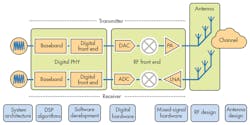What You Need to Become a Multi-Functional Engineer
With the current pace of innovation in wireless technology, the days of domain experts working in silos are numbered. Wireless engineering teams know that in order to keep up with the demands of next-generation systems, they need a more integrated approach. It starts with enabling team members to become multi-functional engineers who can comfortably work in the digital, RF, and system domains (see figure).
Domain specialists productively use tools that are tailored to their task, such as modeling RF architectures, designing digital hardware, and developing algorithms. But those tools don’t help specialists understand how their individual work fits into the rest of the system. Because the performance of digital, RF, and antenna designs are so tightly coupled, using tools that bridge those domains has become essential.
The Expertise Explosion
The tools capable of supporting the work of the multi-functional wireless engineer are already on the market. They are particularly useful for advanced research and design problems, such as modeling multi-antenna (MIMO) systems found in LTE and WLAN systems and 5G proposals, including antenna arrays, propagation patterns, and beamforming.
When working on these or other advanced technologies, wireless engineers have to focus on accelerating research and innovation, while minimizing the time and resources spent on programming, debugging software, or building FPGA hardware realization of their design ideas. For a typical team that consists of engineers with strong signal processing and algorithm development backgrounds—but relatively little experience with RF design or hardware implementation—it is often difficult to simulate or prototype complete radio designs without outside assistance. They are similarly challenged by problems such as developing massive multi-antenna systems that depend on understanding the behavior of highly coupled digital, RF, and antenna elements.
The expertise needed to develop wireless technology is exploding. This is major challenge for R&D teams as they race to deliver the next breakthrough. The days of domain experts working separately, using separate tools, are numbered. Fortunately, there is a better way.
Transforming Wireless System Design with MATLAB and Simulink
Many of these teams recognize the need for a software environment that can encompass algorithm design, system simulation, over-the-air testing, prototyping, and implementation. Compared with groups still designing in silos, successful wireless teams are turning to MATLAB and Simulink as platforms that can help teams integrate multiple engineering disciplines into a coherent workflow.
Wireless engineers are leveraging MATLAB algorithms all the way to full system simulation and implementation of LTE, WLAN, 5G, and other wireless systems. These engineers use MATLAB and Simulink to integrate RF, mixed-signal, and digital technologies into multi-domain system models; connect to hardware for over-the-air testing with live signals; and prototype and implement their designs on a range of hardware.
By developing fixed point-algorithms directly in MATLAB and Simulink, then verifying them in system-level simulations, R&D engineers can rapidly iterate on new design concepts. Once the algorithm runs correctly in simulation, the engineers can automatically generate synthesizable Verilog or VHDL code for deployment to an FPGA-based testbed with the click of a button.
The Future of the Multi-Functional Engineer
Traditionally, digital communications, RF, and antenna engineers have worked in different environments, with integration occurring when the first hardware prototype was developed. The advent of highly integrated RF transceivers has put a strain on this workflow. Now wireless engineers can use MATLAB and Simulink to model, simulate, and analyze complex RF front ends that include RF, analog, digital, and control logic components.
Together, this enables an integrated workflow that unifies design of algorithms and RF components, system simulation, prototyping, testing, and implementation. As a result, engineers can eliminate steps and correct design problems before moving to implementation, accelerating delivery of error-free prototypes and products for the next generation of wireless communications systems.
As long as the pace of wireless technology continues, the need for the multi-functional engineer will only increase. Will you be ready?


